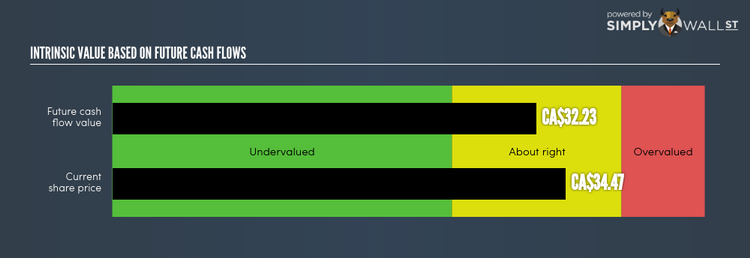Is Power Financial Corporation (TSE:PWF) Expensive For A Reason? A Look At The Intrinsic Value

Pricing insurance stocks such as PWF is particularly challenging. Given that these companies adhere to a different set of rules relative to other companies, their cash flows should also be valued differently. Industry-specific factors, such as gross written premiums are crucial in understanding how insurance companies make money. Emphasizing line items like book values, in addition to the return and cost of equity, can be beneficial for evaluating PWF’s true value. Below I’ll take you through how to value PWF in a relatively effective and simple approach. See our latest analysis for Power Financial
What Is The Excess Return Model?
Two main things that set financial stocks apart from the rest are regulation and asset composition. Strict regulatory environment in Canada’s finance industry reduces PWF’s financial flexibility. In addition to this, insurance companies generally don’t hold large portions of tangible assets on their balance sheet. As traditional valuation models put weight on inputs such as capex and depreciation, which is less meaningful for finacial firms, the Excess Return model places importance on forecasting stable earnings and book values.
Calculating PWF’s Value
The key belief for this model is that equity value is how much the firm can earn, over and above its cost of equity, given the level of equity it has in the company at the moment. The returns above the cost of equity is known as excess returns:
Excess Return Per Share = (Stable Return On Equity – Cost Of Equity) (Book Value Of Equity Per Share)
= (10.84% – 9.95%) * CA$24.58 = CA$0.26
Excess Return Per Share is used to calculate the terminal value of PWF, which is how much the business is expected to continue to generate over the upcoming years, in perpetuity. This is a common component of discounted cash flow models:
Terminal Value Per Share = Excess Return Per Share / (Cost of Equity – Expected Growth Rate)
= CA$0.26 / (9.95% – 2.13%) = CA$3.3
These factors are combined to calculate the true value of PWF’s stock:
Value Per Share = Book Value of Equity Per Share + Terminal Value Per Share
= CA$24.58 + CA$3.3 = CA$32.23
Compared to the current share price of CA$34.47, PWF is trading in-line with its true value. This means there’s no real upside in buying PWF at its current price. Valuation is only one side of the coin when you’re looking to invest, or sell, PWF. Fundamental factors are key to determining if PWF fits with the rest of your portfolio holdings.
Next Steps:
For insurance companies, there are three key aspects you should look at:
1. Financial health: Does it have a healthy balance sheet? Take a look at our free bank analysis with six simple checks on things like leverage and risk.
2. Future earnings: What does the market think of PWF going forward? Our analyst growth expectation chart helps visualize PWF’s growth potential over the upcoming years.
3. Dividends: Most people buy financial stocks for their healthy and stable dividends. Check out whether PWF is a dividend Rockstar with our historical and future dividend analysis.
For more details and sources, take a look at our full calculation on PWF here.
To help readers see pass the short term volatility of the financial market, we aim to bring you a long-term focused research analysis purely driven by fundamental data. Note that our analysis does not factor in the latest price sensitive company announcements.
The author is an independent contributor and at the time of publication had no position in the stocks mentioned.

